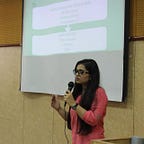MakeHarvard 2019
So what is hackathon?
An event where people in varied fields of technology, design and/or business come together to build a product in a very short span of time, typically 24–48 hours. I love the concept of hackathons! They not only give you great ideas by being in a room of smart and enthusiastic people but provide an excellent opportunity to also exercise your team building and rapid prototyping skills.
Being keen on upcoming hackathons, I came across makeHarvard- Harvard’s annual engineering makeathon which looked enticing and different from traditional hackathons. There was access to rapid-prototyping equipment like 3D printers and laser cutters to produce engineering prototypes in 24 hours. I decided to give it a shot and applied for it. After receiving an acceptance e-mail I was still not very sure of attending it but am so glad to have been there!
Hackalist, Major League Hacking and devpost are good places to look for upcoming hackathons.
How do you find a team?
Your team plays a very crucial role in determining your hackathon experience. Team building should ideally start soon after you make your decision to attend the hackathon. There are groups created on Facebook, Slack after the decisions are rolled by the hackathon organizers.
It is important to understand your own skill-set and what role you can play the best in a team and try teaming up with people having complementary skill-set to have a well-balanced and all-rounded team. For instance, if you are a software developer try looking for a graphic designer to team up with. The ideal team composition also depends on the nature of hackathon. Team size is typically 3–5 members.
I formed my team online and tried having people with diverse skill-sets. Being a makeathon, it was important to have someone with hardware knowledge and 3D-modeling on the team. My team had 4 members.
How did you choose your idea?
The initial phase of brainstorming ideas can be rough considering different people willing to work on different things. It is important to keep brainstorming efficient and letting everyone share their opinions or choice of ideas. You can start discussing your ideas soon after forming your groups.
We initially had formulated an idea an discussed it online but were still open to other ideas. Talking to sponsors at the hackathon, we decided to work on one of the sponsored statement by BMW to build a shared, connected application of augmented or virtual reality in the context of automotive design, in-cabin vehicle interaction, or automotive manufacturing facilities.
With self-driving cars coming in, we have to adapt and start thinking of what to come next. We are living in an increasingly interconnected and digitally smart world. Advertisers know this and have adjusted their budgets and business models accordingly. Companies such as Google and Facebook are built around massive digital ad networks. There is a huge new business opportunity for the first vehicle manufacturers to take this further by making it a real-time immersive experience while driving.
Parking would just be the beginning, we could use this technology for restaurants, hotels and many more. Deep integration with smart cities would make the driving experience more immersive, interactive, and efficient. By providing instant real-time information to the driver would enable smarter and easier decision making while on the road and take the driving experience to the next level. Taking this another step further would be to take advantage of this technology for your day-to-day activities. One example that we implemented, would be finding parking spots.
How was your ‘making’ experience?
Our demo included a laser-cut car model with our AR app serving as the windshield pop-up demo. We demonstrated a driving experience where on encountering Lululemon in the field of vision, a video advertisement started playing showing the available deals and discounts at the store.
Moving further it also alerted the driver about available parking lots.
And the winner is…
The team was slightly hoping but was not very positive about winning the sponsored award but we ended up winning 2 awards!
My team won BMW’s award for best tech applied and also Harvard Innovation Lab’s ‘Most likely to be a Unicorn’ award for the most futuristic and innovative product to become a Silicon Valley unicorn.
We all won an Oculus Go apart from the schwag and cash prize.
What did I Learn?
I got to be at Harvard , winner of the awards and saw the beautiful campus!
I made some cool friends! I met people prototyping and building on amazing ideas who had traveled from different countries for the event!
I got a glimpse of what goes behind successful products- the team, the execution plan, and the launch all play an equally important role. Apart from the technology piece, the design and the pitch are detrimental to a product’s success.
For more on our demo and submission-
